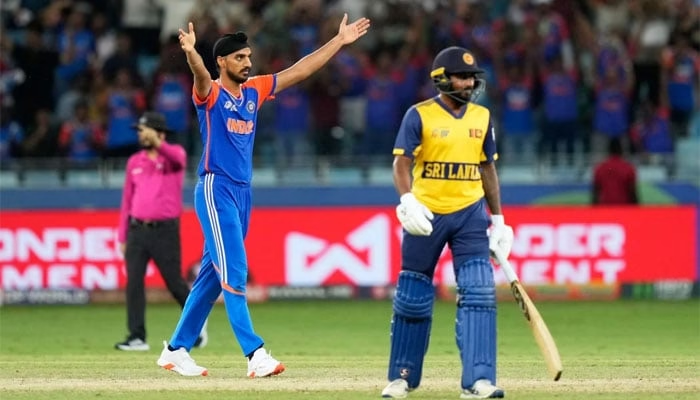Cricket is full of unexpected twists, and the Asia Cup Super Four clash between India and Sri Lanka proved it once again. Fans are still debating the question: Did 3 Sri Lankan players get out in the Super Over? The confusion arose during a dramatic finish when India’s Arshdeep Singh bowled a high-pressure over that left both players and spectators puzzled about how the rules were applied.
Did 3 Sri Lankan Players Get Out in the Super Over?
The question of whether three Sri Lankan players were dismissed in the Super Over became the focal point of post-match conversations. Arshdeep Singh began the Super Over for India, immediately making an impact by dismissing Kusal Perera on the very first ball. With the help of Rinku Singh, Perera’s wicket left Sri Lanka under immense pressure.
Later in the over, a peculiar situation unfolded. On the fourth ball, batter Shanaka tried to steal a run after missing a delivery. Arshdeep appealed for a catch, while the Indian wicketkeeper dislodged the stumps, seemingly completing a run-out. The on-field umpire ruled him out, sparking celebration among Indian players.
However, Shanaka immediately went for a review. Replays confirmed that there was no edge, so the catch appeal was invalid. Because the original decision was made only on the catch, and not the run-out, Shanaka was reinstated as not out under cricket’s laws. This led to massive confusion among fans, who believed that three Sri Lankan players had been dismissed in one Super Over.
Finally, on the last ball, Arshdeep bowled brilliantly again and clean-bowled Shanaka, officially ending the Super Over with two confirmed dismissals.
Why Did It Seem Like 3 Sri Lankan Players Were Out?
The confusion around whether 3 Sri Lankan players got out in the Super Over stems from how appeals work in cricket. When a bowler or fielding team appeals, the umpire is only allowed to rule on the specific form of dismissal being requested. In Shanaka’s case, Arshdeep and the Indian team appealed for a catch, not a run-out.
Once the third umpire confirmed there was no edge, the appeal ended there. Even though Shanaka was visibly short of his crease, the rules did not allow the umpire to declare him run-out unless that was specifically appealed for. This technicality left many fans frustrated, as the visuals suggested a clear dismissal.
Match Context Beyond the Super Over
The drama of whether 3 Sri Lankan players got out in the Super Over overshadowed what had been a thrilling contest. India batted first and set a strong total of 202 for 5, with impressive performances from their top-order batsmen. Sri Lanka matched the challenge, also scoring 202 for 5 in their 20 overs, forcing the match into a Super Over — one of the rarest outcomes in international cricket.
In the Super Over, Sri Lanka struggled against disciplined bowling from Arshdeep Singh. With only three runs scored and two official dismissals, India needed a modest target, which they chased down easily in the very first ball.
Did 3 Sri Lankan Players Get Out in the Super Over? The Laws Explained
According to the International Cricket Council (ICC) playing conditions, an umpire’s decision must be based on the appeal made. If the appeal is for a catch and the batter is not caught, the umpire cannot then change the ruling to a run-out unless the fielding side explicitly appeals for it.
This law is designed to keep the game structured, but it often leads to controversial scenarios, such as this one. The Shanaka incident demonstrates how laws can sometimes appear unfair to fans watching in real time.
Fan Reactions and Wider Impact
Social media platforms lit up with debates over whether 3 Sri Lankan players actually got out in the Super Over. Many fans felt that cricket’s laws need updating to automatically check for all possible dismissals when technology is used. Others defended the rule, arguing that appeals are a crucial part of cricket’s traditional framework.
The Asia Cup itself saw record-breaking engagement this year, with ICC reporting digital viewership surpassing 250 million across platforms. Incidents like the Shanaka ruling only added to the buzz, keeping cricket at the center of sporting discussions worldwide.
So, did 3 Sri Lankan players get out in the Super Over? Technically, no. Only two dismissals were officially recorded — Kusal Perera on the first ball and Shanaka on the last. The controversial fourth-ball incident created the illusion of a third dismissal, but under cricket’s strict appeal-based laws, Shanaka was reinstated as not out.
This moment will be remembered as one of the most debated incidents in Asia Cup history, not just for the result but for how it showcased the complexities of cricket’s rules. The Shanaka controversy serves as a reminder that while cricket is a game of numbers, it is also a game of laws — and sometimes, those laws leave fans asking more questions than they answer.



